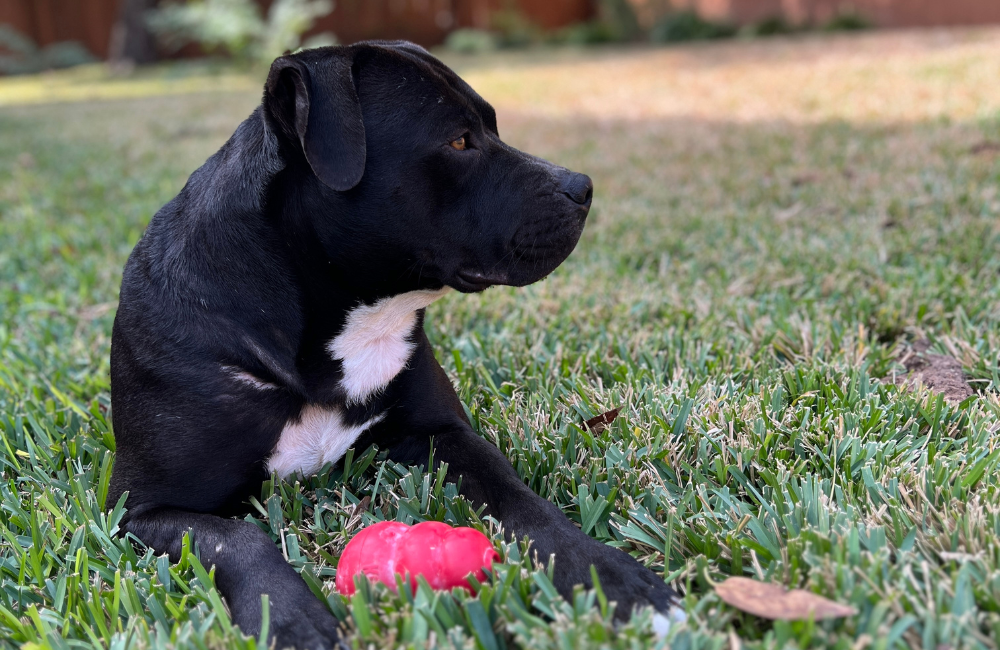Love-A-Bull is unable to accept lost/stray dogs. However, we are eager to try to help you re-home a homeless dog with the following resources. This page is for people who are trying to re-home a stray or rescued pit bull. You can also reach out to other Best Friends Network Partners here.
Note: If you currently work/volunteer in a rural Texas shelter and think you may have a candidate for our Adopt-A-Bulls rescue program, please complete our dog info form.
I Found A Dog
Before you try to find a new home for a lost dog, please make every possible effort to find the dog’s original family. Someone out there might be looking for their beloved family member.
Legal requirements
In many places, there is a “holding period” during which you cannot legally re-home a stray dog–you are required to try and find the dog’s home during this time. Only after the holding period has expired, with no ownership claims on the stray, can you start the rehoming process. Check with your local animal control to find out what you are legally required to do before you can re-home a stray dog.
“Think Lost, Not Stray”
Accidents happen, and dogs get loose sometimes. A lost dog that is skinny, dirty, or injured may have become that way during the time that it was running loose. Lost dogs are often frightened or skittish. It doesn’t necessarily mean that the dog was abused or neglected.
Follow these important steps to try to reunite a lost dog with its family:
- Check for tags. A dog with a collar and tags is the easiest dog to return to its family. An ID tag, a rabies tag, and a microchip tag all carry phone numbers that you can call to report finding a dog. The issuers of these tags should have contact information for the person who owns the dog.
- Check for a microchip. Take the dog to your local animal control office or veterinarian and ask them to scan for a microchip. Microchips can provide an owner’s contact information.
- Contact animal control. Owners are most likely to head to the nearest animal shelter when they lose their pet. Some animal control departments, including Town Lake, will post Found Dog notices online and in their offices. This keeps the dog out of the shelter but still gives owners a way to look for their dog.
- Post notices in the area where the dog was found.
- Post notices online and in local media. Petfinder and your local newspaper are just a few places where you can post lost dog notices.
- Watch for Lost Dog notices online and in the area where the dog was found.
I Rescued a Dog
If you have done everything you can to try and reunite a lost dog with its family, or if you have rescued an unwanted dog from a bad situation, the following information is for you in order to assist in making your rescue dog suitable for adoption.
Get Your Dog Ready
Ensure that your dog is up to date on all their vaccinations, i.e. Rabies, DHPP and Bordatella. Don’t forget about heartworm, flea and tick preventatives as well. If your dog is not already neutered or spayed, it’s a great idea to do so, so that the dog is less desirable to a breeder or dogfighter. Emancipet has low-cost options, and LOVE-A-BULL has additional spay/neuter resources here.
Groom your dog. You want your dog to look beautiful and make a good impression. He needs to be clean and well-dressed! Bathe him, trim his nails and clean his ears. If you can’t do these things yourself, take him to a groomer. Think about purchasing a new collar, we suggest a martingale because they are more difficult to slip out of and don’t forget a new leash to go along with the collar.
Set an adoption fee. The fee should cover any reasonable medical expenses, i.e. routine or preventative care and possible new items such as crate, food, bowls, collar/leash. An adoption fee may also help ward off those individuals who do not have the best interest of your dog in mind.
Spread the Word
Word of mouth doesn’t go very far, so don’t be afraid to use any marketing avenue at your disposal. Ways to advertise include posting flyers at veterinarian’s offices, groomers, pet stores, anywhere there is a public bulletin board and even Craigslist. Done right, marketing is the most effective way to reach the largest number of people. It’s easy to write a good ad that will weed out poor adoption prospects. Check out the Austin PASS (Positive Alternatives to Shelter Surrender) page here.
Your ad should give a short description of your dog, his needs, your requirements for a home and of course, your contact information. The description should include his breed, color, sex, etc. Hints: if your dog is less than 2 years old, state his age in months so he’ll be perceived as the young dog he is. If he’s over three, just say that he’s an “adult.”
Emphasize your dog’s good points: Is he friendly? Housebroken? Crate trained? Well-mannered? Loves kids? Does he do tricks? Has he had any training? Don’t keep it a secret but don’t exaggerate either. Knowing his name doesn’t make him “well-trained”!
State any definite requirements you might have for his new home: fenced yard, no cats, kids over 10, etc. Try to say these in a positive way – for example, stating “older children recommended” sounds better than “no kids under 10”. If your pit bull doesn’t like other pets, say “should be only pet” rather than “doesn’t like other animals.”
Always state that references are required. This tells people that you’re being selective and that you’re not going to give your dog to just anybody. This statement will do a lot to keep people with bad intentions from dialing your number.
Never include the phrase “free to good home” in your ad even if you’re not planning to charge a fee. If possible, don’t put in any reference to a price at all. The chance at a “free” dog will bring lots of calls, but most of them won’t be the kind of people you’re looking for and many of them will be people you’d rather not talk to at all.
For the local paper, your ad might read:
Pit bull: neutered male. Friendly, housebroken, well-behaved.
Best with children over 10. Fenced yard, references and home
visit required. $150. Karen 555-1234
Along with your local newspaper, advertise in all major papers within an hour and a half’s drive. Schedule your ad so that it appears in Sunday’s paper – the issue that’s the most well-read and widely circulated. If your budget is very limited, choose to run your ad only on Sundays rather than throughout the week. Nearly every community also has small, weekly “budget-shopper” newspapers that offer inexpensive classified ads. Take advantage of them!
There are many places online to advertise, too, including Adopt-A-Pet and Paws Like Me. Paws Like Me is essentially a dating service for people who are looking for their new family member. It asks questions in order to match the right dog to the right person based on personality. Paws Like Me also assist in adoption applications and adoption fees and allows you to donate to a local rescue/shelter. We’d love it if you picked LOVE-A-BULL!
For flyers: Take some good quality cute photos of your dog that highlight his looks and personality. Use an online picture editor such as canva, pixlr or pic monkey to make attractive flyers. Your flyer doesn’t have to be expensive or professional, just neat and eye-catching. Since you’re not paying for words, you can write more about your dog than you could in a newspaper ad. Be descriptive!
Post your flyers at grocery stores, department stores, vets’ offices, pet supply stores, grooming shops, factories, malls, etc. – anywhere you can find a public bulletin board. If you have friends in a nearby city, mail them a supply of flyers and ask them to post them for you.
Don’t be discouraged if your phone isn’t ringing right away. Most people give up too soon. It can take a month or more to find a new, suitable home for your dog, so plan on advertising for several weeks. Make sure to put a phone number and/or email in the ads so you can be easily reached and make sure you have a voicemail set up if you are unavailable.
Potential Adopters
Screen potential adopters carefully and do a home visit if you can. Please visit Screening Potential Homes for details about interviews, home visits, adoption contracts, and saying goodbye to your rescue.

